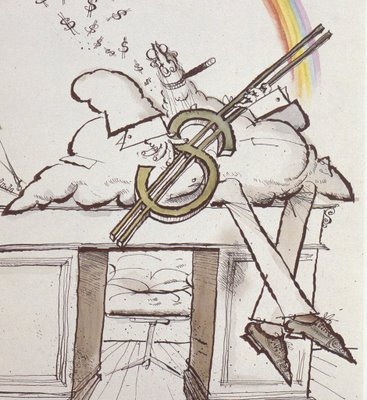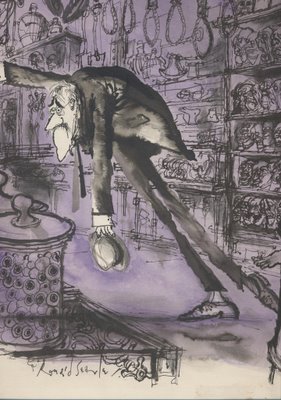
The illustrator Rockwell Kent (1882 - 1971) loved humanity with great passion. Unfortunately, he was an utter jerk when it came to loving individual human beings.
Kent was famous for his illustrations for Moby Dick, Candide, Shakespeare and Chaucer. He was also the author of several acclaimed books, an explorer, an architect, a dairy farmer, a carpenter, a fisherman, a sailor and an outspoken advocate of socialism who was awarded the Lenin Peace Prize by the Soviet Union for his work to achieve peace and brotherhood.

Kent had many wild adventures around the world. He hiked through jungles and over mountains. He explored islands and traveled on freighter ships. Once he attempted to sail around Cape Horn (at the southern tip of South America) in a ramshackle life boat that he bought for a few dollars. Wrote one commentator:
This region, boasting probably the world's worst climate, is buffeted incessantly by winds, swiftly alternating with rain, hail and snow. It is the legendary graveyard of ships and sailors, and Kent [had] the half-formed idea of trying his mettle against the hazardous adventure of sailing "round the Horn."He was shipwrecked in Greenland and Alaska and lived for extended periods of time north of the Arctic Circle in desolate places like Ubekendt Ejland (Unknown Island). But his first love was painting and he painted almost every day.

Kent's artistic mentor was the painter Abbott Thayer. While living as a guest in Thayer's house, Kent married Thayer's 17 year old niece over the objection of her family. Four months after the wedding, he resumed a love affair with an old flame. Kent went on to have torrid affairs with a variety of girlfriends while his devoted wife stayed at home and bore him five children. (When one of his girlfriends became pregnant, Kent and his wife had to sell everything they owned to pay her off.) When his fifth child was born, Kent decided that his wife's clinging ways were unbearable, so the couple divorced. Kent learned from this experience and made sure all of his future children were illegitimate. Kent's second wife, Frances, may have hoped Kent was willing to settle down because he built a dream house with her out in the country and named it "Asgaard" after the Norse home of the gods. But at the housewarming party that Kent and Frances held for their friends, Kent overheard someone planning a dangerous boat expedition to Greenland and immediately abandoned Frances and Asgaard for this new adventure. Kent did marry a third time, to a woman the age of his youngest daughter.
Kent courted these women using artwork and poetry, and he praised their beauty with great eloquence. He always felt bad (and a little surprised) when they took the news of his infidelity so hard. One former showgirl committed suicide, jumping to her death into the sea. Perhaps it would have been difficult for a wife to accompany Kent on his rugged travels. Kent recounted one particularly horrifying shipwreck in his autobiography, It's Me O Lord:
Against the hurricane that woke us, sweeping down off the lofty plateau of the inland ice... we could do nothing but... hang onto our anchor ropes. And once the anchors failed to hold, the game was up.Kent's tiny boat capsized. He and his two companions dragged themselves to shore and trekked 36 hours over rugged terrain with no shelter before they stumbled across an Inuit fisherman. None of them spoke Inuit, yet Kent managed to negotiate food, shelter and a young Inuit native girl.

Even though Kent had no space for a wife on his journeys, he always managed to find room for his paints, brushes and canvases. Following the shipwreck mentioned above, Kent returned to salvage his art supplies and spent two months painting that "vast wonderland of sea and mountain."
I have long been fascinated by the selfishness of artists. Some artists place the demands of their art above the welfare of their family and friends. Sometimes the resulting art is so beautiful, the trade off seems worth it to those of us who aren't personally affected. But it is always difficult to draw a bright line between artists who make sacrifices to protect their art and those who are merely self centered. Through the generations, a lot of collateral damage has been caused by artists fighting for their artistic lives.
Kent lived to be 89. Despite all his advetures, he seemed to have had a wistful old age. In one of his books, he described a poem-song he had learned from the Eskimoes about an old man who remembers
A sick old man could no longer hope to hang onto a woman, so he wishes hisold times when I had strength to cut and flay great beasts.
Three great beasts could I cut up while the sun slowly went his way across the sky.
woman away in the house of another,
in the house of a man who may be her refuge, firm and sure as the strong winter ice.
Sad at heart, I wish her away in the house of a stronger protector now that I myself lack strength even to rise from where I lie.

























